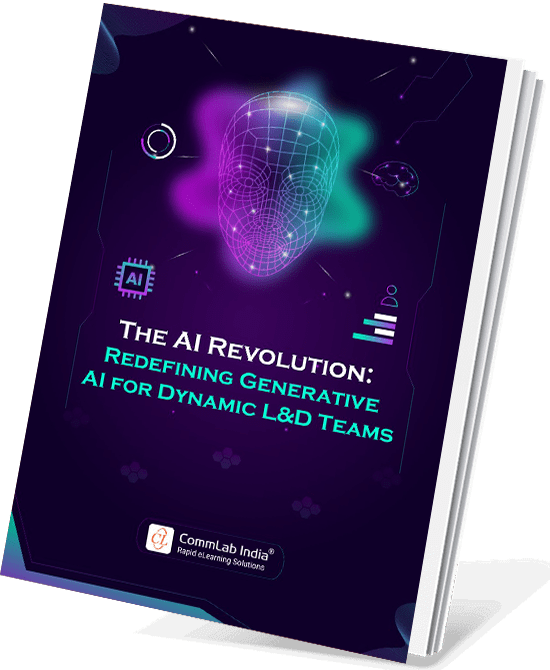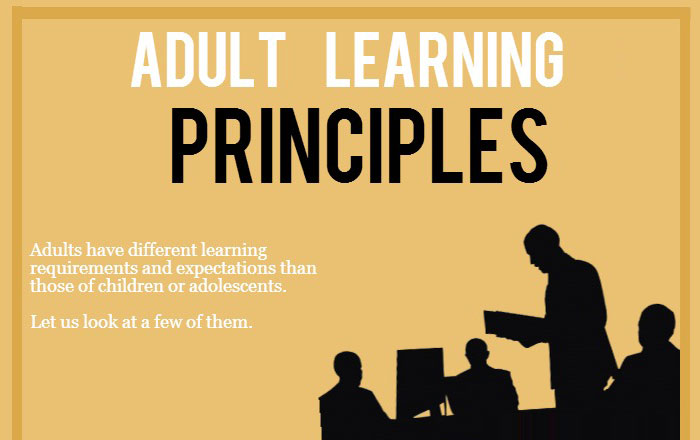Business Case for Leveraging AI in Custom eLearning for Corporate Training

As exciting as it is to see how quickly the corporate world is changing, it’s important for businesses to understand that in this competitive world, staying ahead is no longer a nice-to-have strategy—it's an absolute must! And to ensure this, businesses must be on a constant lookout for innovative ways to upskill and reskill their workforce. Not just that, the innovative methods must align with the learning style and preferences of the modern-day workforce to ensure maximum efficiency. In all this situation, custom eLearning has emerged as a powerful tool. But with the integration of Artificial Intelligence (AI), custom eLearning doesn't just remain a tool, it becomes a game-changer. This business case styled blog explores the profound impact of leveraging AI in custom eLearning for corporate training. By the end of this article, it will be clear that investing in AI-driven custom eLearning is not just a wise choice—it's the best choice.
→ Download eBook: Impact of Generative AI on L&D Teams
Table of Contents
- What Are the Different Challenges Faced by Organizations in their Training Programs?
- What Are the Different Options for Delivering Corporate Training?
- Why Are Traditional Training Methods Ineffective?
- What Is the Cost-Benefit Analysis For AI-Driven Custom eLearning?
- How Leveraging AI in Custom eLearning Program Maximizes Training ROI?
- How to Conduct Risk Assessment for AI-Integrated Custom eLearning?
What Are the Different Challenges Faced by Organizations in their Training Programs?
Yes, Conducting an Effective Corporate Training Is NOT Easy!
Here are the common hurdles organizations face.
- Diverse learning needs
- Limited engagement
- Scalability issues
- Inefficient use of resources
Keep reading to know how combining AI with custom eLearning can help you tackle these challenges effectively.
Diverse Learning Needs
In today’s business world, employees come from varied backgrounds. Each employee has their unique knowledge, skills, learning styles, and preferences. While this diversity is good, at the same time, it poses a significant challenge for organizations in terms of designing and developing effective employee training programs.
For instance, consider a multinational company that has a workforce spread across different regions. Employees in the IT department might already be proficient in certain software, while those in the marketing department may only have a basic understanding of the same tools. A one-size-fits-all training module that assumes a uniform level of knowledge will either overwhelm the beginners or bore the experts.
Moreover, learning styles vary widely. Some employees might be visual learners who benefit from video tutorials, animations, infographics, etc., while others might prefer text-based content or hands-on activities.

Without addressing these differences, the training program is prone to the risks being ineffective as it won’t resonate with all learners. Failing to cater to these distinct needs could lead to frustration, decreased productivity, and resistance to contitnuing or completing the training program.
Limited Engagement
Learner engagement is the lifeblood of any successful training program. Unfortunately, traditional eLearning methods often struggle to keep the learners attentive or engaged in the learning process. The consequence is low completion rates, limited retention, and ultimately, minimal impact on the organization.
Let’s understand this with the help of an example. Compliance training modules are essential for ensuring that employees understand company policies and legal requirements. Right? But they are often designed and developed in a dry, text-heavy, and repetitive way. This leads to employees losing interest quickly and simply clicking through slides just to complete the course without really understanding the material. The overall result of this is that although it might seem like the learners have finished the module but they don’t truly understand the content. It defeats the entire purpose of the training.
In contrast to this, a well-designed, engaging training program should include interactive elements like quizzes, simulations, and real-world scenarios that require active participation. Moreover, leveraging multimedia elements also proves beneficial in boosting learner engagement.

Without these engaging elements, traditional eLearning can feel like a chore… something employees do because they have to, not because they want to. Lack of engagement diminishes the effectiveness of the training, leading to a poor training return on investment (ROI).
Scalability Issues
Scaling training programs to meet the diverse needs of a large and globally dispersed workforce is another significant challenge. Designing and developing training courses for different roles, locations, and learning speeds can be both time-consuming and costly.
If a global company needs to train employees in multiple countries, it will need the content to be translated into several languages, adapted to different cultural contexts, and modified to comply with local regulations. Along with this, there’s a chance that different departments within the company may require specialized training content.
Manually creating, updating, and delivering a vast array of eLearning courses quickly can become overwhelming. On top of this, eLearning translations is a whole new story. It not only requires significant resources but also constant coordination to ensure that the training remains relevant and effective across the entire organization. The more complex and varied the workforce, the more challenging it becomes to scale training efforts without compromising quality or increasing costs.
Inefficient Use of Resources
Without the ability to tailor training courses to individual needs, resources are often wasted on content that doesn’t meet the learner’s requirements. This inefficiency can manifest in several ways, from time spent on irrelevant training to the financial cost of developing training material that doesn’t drive results.
Imagine a scenario where a company invests heavily in creating a comprehensive product training program for a new software tool. The program is rolled out company-wide, regardless of the varying levels of familiarity with the software among employees. Some employees may already be proficient and find the training redundant, while others might need more foundational knowledge to benefit from the program.
In this case, the time and effort spent on eLearning design and development is not utilized effectively. Employees who find the content irrelevant may disengage, while those who need more support may not be able to understand it effectively. All this leads to suboptimal training outcomes. In addition to this, the company may incur unnecessary costs by developing catalog courses, instead of focusing resources on targeted, personalized training that addresses specific needs.
In a world where "time is money," such inefficiencies can be costly, not just in terms of budget, but also in missed opportunities for growth. When training doesn’t hit the mark, the company misses out on the chance to fully equip its employees with the skills they need to contribute to the organization’s success.

Redefining Generative AI for Dynamic L&D Teams
Discover how Generative AI is breaking boundaries and empowering L&D Teams
- Why leverage Generative AI for L&D?
- What training managers should know about generative AI
- Ethical conundrums for Generative AI: Use cases
- Future prospects of Generative AI
What Are the Different Options for Delivering Corporate Training?
When it comes to addressing the challenges associated with training methods of corporate training, there are a variety of solutions that can be considered. Here’s an infographic for a quick overview.

Now let’s explore the viability of each option in detail.
Continue with Traditional eLearning
Sticking to existing eLearning methods may seem like the path of least resistance, but it doesn't address the core issues of personalization, engagement, and scalability. It’s like trying to fit a square peg into a round hole.
Invest in In-Person Training
While instructor-led training (ILT) offers an optimum level of engagement and interaction, it poses a major challenge in terms of scalability and can be costly. Furthermore, it lacks the flexibility to cater to individual learning pace and preferences.
Leveraging AI in Custom eLearning (Recommended Option)
AI-driven custom eLearning leverages advanced algorithms to analyze learner data, deliver personalized content, and adapt to the unique needs of each employee. This option not only addresses the current challenges that organizations face through conventional in-person or eLearning training methods but also opens up new possibilities for enhancing corporate training and maximizing training ROI.

Why Are Traditional Training Methods Ineffective?
Do you agree that in the world of corporate training, one size no longer fits all? Yes, right? However, the sad truth is that conventional approach to employee training often falls short of addressing the diverse learning needs of a modern workforce. It is more focused on generic topics and information which often results in disengaged, distracted learners. The lack of engagement among learners further drills down, resulting in poor knowledge retention rates and limited application of new skills.

Redefining Generative AI for Dynamic L&D Teams
Discover how Generative AI is breaking boundaries and empowering L&D Teams
- Why leverage Generative AI for L&D?
- What training managers should know about generative AI
- Ethical conundrums for Generative AI: Use cases
- Future prospects of Generative AI
What Is the Cost-Benefit Analysis For AI-Driven Custom eLearning?
It’s no secret that when you decide to implement AI in custom eLearning, it requires an initial investment. This investment is in terms of technology, content development, and integration. However, it’s worth noting that the benefits far outweigh the costs.

Let’s understand this thoroughly.
Costs Involved in AI-Driven Custom eLearning
- Technological Investment: Purchasing or developing AI tools and eLearning platforms.
- Content Development: Creating high-quality, engaging, and customized courses requires significant resources, including skilled personnel, time, and technology, even with the aid of AI. With that said, content development is also a major cost driver in AI-driven custom eLearning due to the need for subject matter expertise, content creation and curation, AI integration, quality assurance, and customization.
- Integration and Training: Costs associated with integrating AI solutions into existing systems and training staff on how to use the new tools.
What Are the Benefits of Leveraging AI for Custom eLearning?
Increased Learner Engagement
As mentioned earlier, traditional classroom settings or standard eLearning courses often rely on one-size-fits-all content. Imagine you're launching a new eLearning module on cybersecurity practices across your company. As per the conventional training setup, you might roll out a course that is filled with text-heavy slides and generic examples. This leads to a dip in learner engagement and knowledge retention rates.
Whereas with custom eLearning solutions backed by Artificial Intelligence (AI), sky is the limit for creating engaging and immersive learning experiences. AI assists training managers in analyzing and understanding the individual learner behavior and preferences. This allows them to create content that caters to the learning needs of employees and aligns with their learning styles.
More amazingly, AI also comes in handy for eLearning developers. Here’s how.

All these elements promote learner attentiveness and engagement. As a result, learners are more invested in the training process, leading to higher retention rates and training ROI.
Personalized Learning Paths
In a diverse team where employees range from fresh graduates to seasoned professionals, personalized learning experiences are an integral part of an effective corporate training program. Custom eLearning combined with AI enables organizations to deliver highly personalized learning experiences. AI has the ability to analyze learner data that allows training managers and instructors to deliver tailored learning material that aligns with employees’ individual learning style, pace, and goals. This helps facilitate a more engaging and effective learning experience.
Additionally, AI can track learner progress and adapt learning paths in real-time to address knowledge gaps and optimize learning outcomes. By providing intelligent recommendations based on learner performance and interests, AI helps learners stay motivated and engaged in their learning process. Overall, the integration of AI in custom eLearning solutions is transforming the corporate training landscape and paving the way for a more efficient and effective learning environment.
For example, consider an experienced project manager, Christopher, who already has a deep understanding of project management principles. The AI might skip the introductory modules for Christopher and instead focus on advanced features of the new tool, offering him case studies and challenges that push his skills further. Meanwhile, for a new team member like Sarah, who’s just starting out, the AI provides foundational content, interactive tutorials, and additional support, ensuring she builds a solid understanding before moving on to more complex topics.
By tailoring the learning experience to each employee's needs, AI ensures that every individual receives the right training at the right time, making the process more efficient and effective for everyone involved.
Scalability
Traditional classroom training requires physical spaces, scheduling, and coordination, all of which become increasingly challenging as organizations grow. Similarly, standard eLearning courses might struggle to keep pace with expanding content needs and diverse learner profiles. On the other hand, AI-driven custom eLearning is inherently and effortlessly scalable. It allows organizations to rapidly develop and deploy training material across various geographies and languages without compromising quality. Whether you’re training a team of 50 or 5,000, AI ensures that each learner receives relevant and up-to-date content tailored to their needs.
For example, if an organization rolls out a safety training program for a manufacturing plant in two different locations. One being Germany and the other one being India. With the help of the AI-powered custom eLearning, it can ensure that the training content includes specific industrial safety protocols for each location. Moreover, the system can adjust the content delivery based on the local culture—offering more direct, data-driven instruction in Germany and a more collaborative, discussion-based approach in India.
This ability to scale training efficiently across diverse geographies and roles without compromising on relevance ensures that every employee receives training that is not only compliant but also highly relevant to their specific work environment.

Redefining Generative AI for Dynamic L&D Teams
Discover how Generative AI is breaking boundaries and empowering L&D Teams
- Why leverage Generative AI for L&D?
- What training managers should know about generative AI
- Ethical conundrums for Generative AI: Use cases
- Future prospects of Generative AI
Efficiency Gains
Have you ever thought how much time do trainers and HR departments spend on routine tasks like grading assessments, tracking learner progress, and providing feedback? Well, the exact number might vary from organization to organization but the overall answer would be… a lot! This is particularly true for large organizations with hundreds or thousands of employees. It’s worth noting that this amount of time could be better spent on strategic activities like developing new training programs, working on L&D strategies, etc. With AI in custom eLearning, it’s possible. AI can automate the monotonous, repetitive tasks so that the L&D professionals can focus on their core responsibilities.
For learners, AI-enabled custom eLearning platforms streamline the learning process by focusing on content that is directly relevant to each learner's role and skill gaps. For example, after an eLearning course on data privacy, the AI system can automatically grade the assessments, providing instant feedback to employees. If an employee consistently answers a certain type of question incorrectly, the AI can immediately recommend additional resources or even adjust the employee’s learning path to include a review of that specific topic.
Unlike traditional methods, AI curates a learning path that hones in on critical skills and knowledge. This targeted approach reduces the time employees spend on training, allowing learners to apply their new skills more quickly and efficiently in their daily tasks. Moreover, the HR department, instead of being bogged down with grading and follow-ups, can focus on developing a more comprehensive data privacy strategy for the entire company. This results in a more productive workforce that can adapt to changing demands with agility.
By automating these routine tasks, AI not only saves time but also ensures that employees receive timely, personalized support, which enhances the overall effectiveness of the training program.
Improved Training ROI
Investing in AI-driven eLearning might seem like a significant upfront cost, but the returns can be substantial. The saying, "The proof of the pudding is in the eating," perfectly captures the essence of this benefit. It reduces costs associated with content creation, delivery, and maintenance by leveraging cutting-edge AI tools and eLearning authoring tools.
Moreover, AI-enabled custom eLearning platforms also allow organizations to automate substantial portions of the custom eLearning development process.
Along with the abovementioned perks, increased learner engagement, efficiency, and scalability options in AI-driven custom eLearning lead to quicker learner progression and improved job performance. As employees become more proficient in their day-to-day tasks, they contribute more effectively to the organization which boosts overall productivity and profitability. In the long run, AI-driven custom eLearning not only optimizes the training budget but also amplifies its impact across the entire organization.
Watch this video to learn how to design assessments in custom eLearning solutions.
How Leveraging AI in Custom eLearning Program Maximizes Training ROI?

As mentioned in the previous section, AI-integrated custom eLearning improves training ROI. In this section, we’ll understand how.
- Reduced Training Costs: Firstly, by automating the mundane, repetitive tasks, AI ensures resource optimization which results in better efficiency and productivity. Moreover, by leveraging AI tools for various labor-intensive tasks involved in the custom eLearning design and development process, organizations can cut back on additional expenses.
- Increased Productivity: With personalized learning paths, relevant training, effective assessments and feedback, employees are more likely to apply their new set of skills in a more effective manner. This translates to increased productivity and superior business outcomes.
- Boosts Employee Performance: While leveraging AI in custom eLearning demands initial investment but the long-term savings steal the show. Reduced training costs and increased productivity combine to boost overall employee performance that yields an impressive training ROI.
How to Conduct Risk Assessment for AI-Integrated Custom eLearning?

Every innovation comes with risks and in such situations, this quote is worth remembering. Implementing AI in custom eLearning is no different. However, with careful planning and risk management, the potential downsides can be mitigated.
What Are the Potential Risks Associated with Integrating AI and Custom eLearning?
It won’t be wrong to say that AI has its flaws and shortcomings. But that’s no reason to give up on the tremendous potential it has to offer. Instead, one can be vigilant about the potential risks and ensure extra caution for desirable, effective results. Let’s take a look at the 3 common potential hurdles associated with combining AI and custom eLearning.
- Data Privacy Concerns: AI relies on data to deliver personalized learning experiences. Therefore, it’s crucial to ensure that employee data is handled securely and in compliance with regulations.
- Resistance to Change: No every employee in the organization might be tech-savvy. Even worse, some of the employees might not even be willing to try and may be resistant to new technology. In such situations, clear communication and training on the benefits and use of AI-driven custom eLearning can be helpful.
- Upfront Costs: Exceeding budget talk is not really the highlight of an L&D team’s day. The initial investment in AI technology can be significant. However, as demonstrated in the cost-benefit analysis, the long-term benefits justify the expenditure.
What Are the Mitigation Strategies for Risks Associated with Leveraging AI in Custom eLearning?
- Have Data Security Measures in Place: Implement robust data protection protocols and ensure compliance with relevant regulations.
- Change Management Plan: Develop a comprehensive plan to manage the transition, including employee training and support.
- Pilot Program: Start with a pilot program to test the effectiveness of AI-driven custom eLearning programs before a full-scale rollout. This will leave some room for adjustments based on feedback and results.
Parting Thoughts!
In the words of Henry Ford, "If everyone is moving forward together, then success takes care of itself." In today’s fast-paced corporate world, organizations can embrace AI in custom eLearning to move forward together. They can ensure that every employee has access to the training they need to succeed. Wish to explore more about Generative AI and how you can make the most of it in your training initiatives? Our eBook on AI for L&D teams is a must-read! Check it out below.





